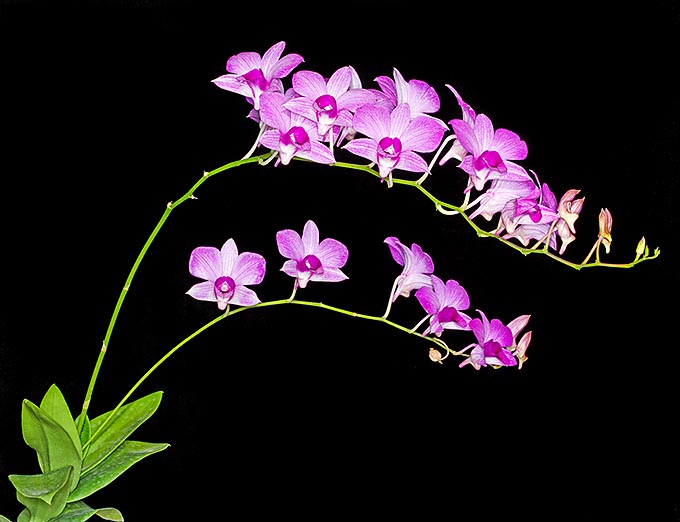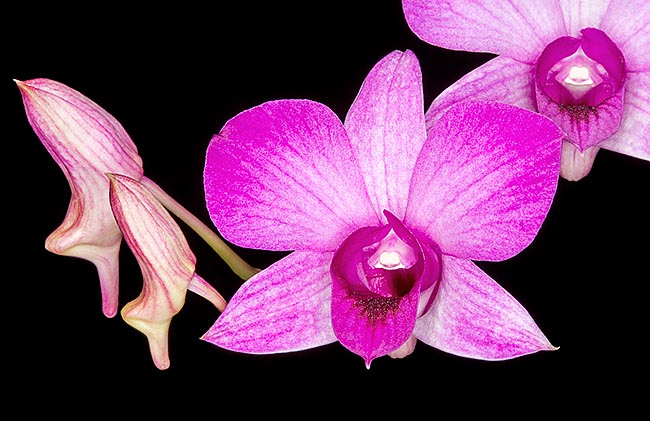Family : Orchidaceae

Text © Pietro Puccio

English translation by Mario Beltramini

Epiphytic species, lithophytic at times, Dendrobium striaenopsis is native to Lesser Sunda Islands © Giuseppe Mazza
The name of the genus is the combination of the Greek substantives “δένδρον” (dendron) = tree and “βίος” (bios) = life, with reference to the numerous species of the genus living on the trees; the name of the species is the combination of the Latin substantive “stria” = streak and -aenopsis, which recalls the name of the Dendrobium phalaenopsis from which mainly differs because of the dark venations on sepals and petals.
The Dendrobium striaenopsis M.A.Clem. & D.L.Jones (1989) is an epiphytic species, less frequently lithophytic, with cylindrical pseudobulbs slightly swollen in the median part, up to about 40 cm long, provided in the upper part of alternate leaves, distichous, ovate to lanceolate, 5-15 cm long and 1-2,5 cm, coriaceous, of glossy intense green colour. Racemose inflorescences from the upper nodes, 10-40 cm long, carrying 8-20 flowers, of 5-7 cm of diameter, with sepals and petals of purple colour with darker venations and dark purple labellum. The sepals are oblong with pointed apex, the lateral ones, merged at the base of the column, form a sort of a spur (mentum), about 1 cm long. Obovate petals, trilobed labellum with roundish lateral lobes surrounding the column and oblong median lobe with pointed apex.
It reproduces by seed, in vitro, and division, to be done by the vegetative restart, with each section provided of at least 3-4 pseudobulbs. Species very similar to the Dendrobium bigibbum Lindl. (1852), requires partial shade, medium-high temperatures, 22-32 °C, and high humidity, 70-85%, with constant ventilation; during the vegetative stasis the temperatures can be averagely lower, with night minimum values not under the 16 °C.

The racemose inflorescences reach at times 40 cm, with also 20 flowers of 5-7 cm of diameter © Giuseppe Mazza
Waterings and nebulisations are to be done with rainwater, from reverse osmosis or demineralised; the fertilizations, duly distributed in way to avoid salts accumulation, are to be done during the vegetative period preferably with balanced hydrosoluble products, with microelements, at half dosage, or less, than what suggested on the package.
It can be mounted on bark, trunks, rafts of cork or of roots of arborescent ferns, or cultivated in pot with much draining and aerated compost, which can be formed by medium sliced bark and charcoal fragments with possible addition of inerts like pieces of clay or of polystyrene, for improving the drainage.
Transplants and repottings are to be done when strictly necessary by the vegetative restart, signalled by the appearance of the new roots. The species is reported in the appendix II of the CITES (species whose trade is internationally ruled).
Synonyms: Dendrobium bigibbum var. albomarginatum Linden (1891); Dendrobium phalaenopsis var. schroderianum Rolfe (1891); Dendrobium phalaenopsis var. schroederianum Rchb.f. ex W.Watson (1891); Dendrobium bigibbum var. albopurpuratum auct. (1895); Dendrobium bigibbum subsp. laratensis Clemesha (1978); Vappodes striaenopsis (M.A.Clem. & D.L.Jones) M.A.Clem. & D.L.Jones (2002).
→ For general notions about ORCHIDACEAE please click here.
